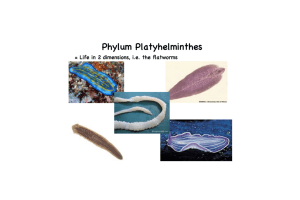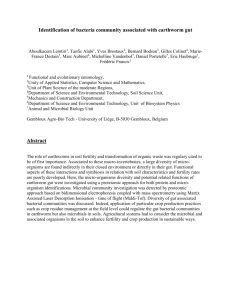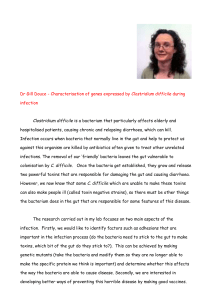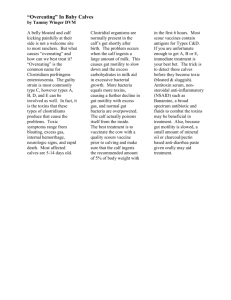the mechanism of osmotic regulation in artemia salina (l.)
advertisement
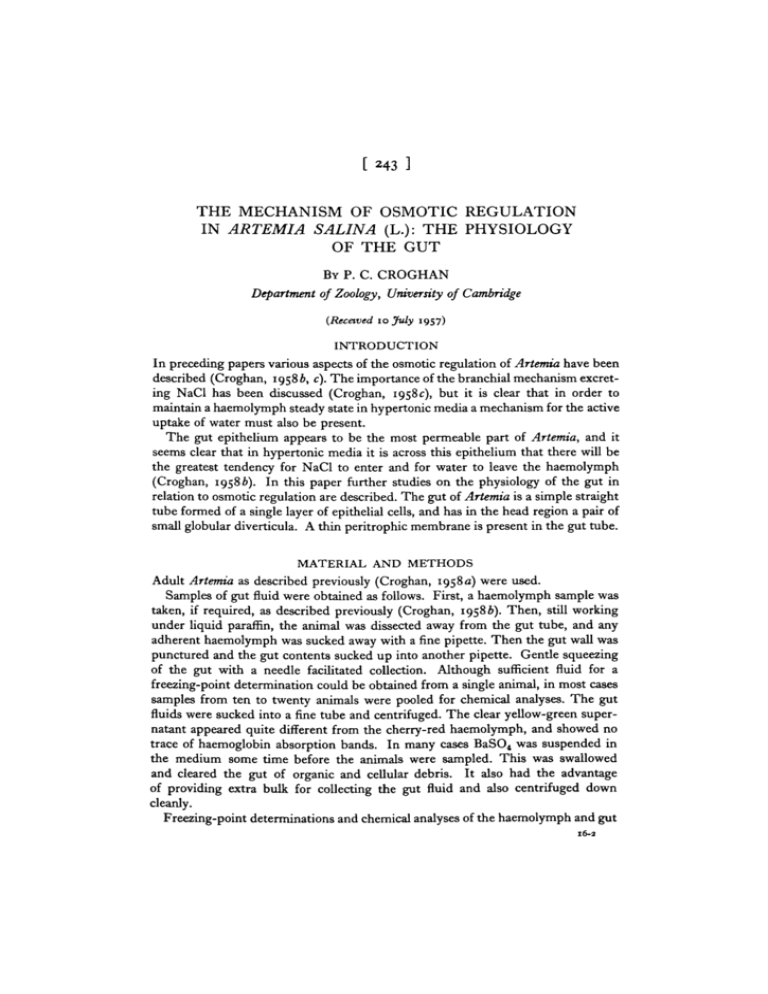
243 THE MECHANISM OF OSMOTIC REGULATION IN ARTEMIA SALINA (L.): THE PHYSIOLOGY OF THE GUT BY P. C. CROGHAN Department of Zoology, University of Cambridge (Received 10 July 1957) INTRODUCTION In preceding papers various aspects of the osmotic regulation of Artemia have been described (Croghan, 19586, c). The importance of the branchial mechanism excreting NaCl has been discussed (Croghan, 1958c), but it is clear that in order to maintain a haemolymph steady state in hypertonic media a mechanism for the active uptake of water must also be present. The gut epithelium appears to be the most permeable part of Artemia, and it seems clear that in hypertonic media it is across this epithelium that there will be the greatest tendency for NaCl to enter and for water to leave the haemolymph (Croghan, 19586). In this paper further studies on the physiology of the gut in relation to osmotic regulation are described. The gut of Artemia is a simple straight tube formed of a single layer of epithelial cells, and has in the head region a pair of small globular diverticula. A thin peritrophic membrane is present in the gut tube. MATERIAL AND METHODS Adult Artemia as described previously (Croghan, 1958a) were used. Samples of gut fluid were obtained as follows. First, a haemolymph sample was taken, if required, as described previously (Croghan, 19586). Then, still working under liquid paraffin, the animal was dissected away from the gut tube, and any adherent haemolymph was sucked away with a fine pipette. Then the gut wall was punctured and the gut contents sucked up into another pipette. Gentle squeezing of the gut with a needle facilitated collection. Although sufficient fluid for a freezing-point determination could be obtained from a single animal, in most cases samples from ten to twenty animals were pooled for chemical analyses. The gut fluids were sucked into a fine tube and centrifuged. The clear yellow-green supernatant appeared quite different from the cherry-red haemolymph, and showed no trace of haemoglobin absorption bands. In many cases BaSO4 was suspended in the medium some time before the animals were sampled. This was swallowed and cleared the gut of organic and cellular debris. It also had the advantage of providing extra bulk for collecting the gut fluid and also centrifuged down cleanly. Freezing-point determinations and chemical analyses of the haemolymph and gut 16-2 244 P- C. CROGHAN fluids were carried out by methods described previously (Croghan, 19586), except that the potassium analyses on the gut fluids were carried out by the method of Ramsay, Brown & Falloon (1953). RESULTS Swallowing behaviour Active animals continuously filter-feed from the medium, and fine particles of charcoal or BaSO4 added as a suspension to the medium are rapidly taken into the gut. On changing the animal from a suspension of say BaSO4 to charcoal, a sharp colour interface in the gut contents rapidly passes back along the intestinal tube. The animal can also be shown to be actively swallowing its medium. Phenol red was dissolved in the medium and the solution filtered. Animals were placed in these media. Within a few hours the entire gut lumen was bright red, indicating that the medium had been swallowed. This swallowing has been observed in all saline media, hyper-, iso- and hypotonic. The dye was confined to the gut lumen and did not enter any other part of the animal. It appeared to be more concentrated in the gut than in the medium. In animals ligatured at the anus, rapid oral swallowing still occurs, and the gut lumen rapidly becomes bright red. Animals ligatured at the neck show a somewhat more variable behaviour, but in most there is evidence of anal swallowing, the rectum first becoming bright red and the dye then spreading slowly forwards. Samples of gut fluid were obtained from animals kept in media containing dissolved phenol red. The results indicated that the dye was in solution in the gut contents and that it was more concentrated than in the medium being swallowed. Some animals were placed in a dilute filtered solution of phenol red in sea water. After 24 hr. the gut contents of about fifteen large animals were pooled and centrifuged to remove food particles. The supernatant, a tiny drop of a very dark red fluid, was pipetted into 1 ml. of dilute ammonia solution. Standards were prepared by using the same pipette and adding different volumes of the coloured medium to 1 ml. volumes of ammonia solution. The final solutions were compared in a Spekker absorptiometer using 2 cm. light path microcells and blue filters. No dye could be detected in the haemolymph, but in the gut lumen the phenol red was about seven times more concentrated than in the medium. These results demonstrate that Artemia rapidly swallows the medium and takes up water from it, thus concentrating the dye. Some animals that had swallowed filtered phenol red sea water for a few hours were placed in filtered uncoloured sea water. Dye was retained in the gut lumen for prolonged periods. Many still retained appreciable amounts even after 72 hr. This confirms that the medium is swallowed at both ends of the gut and that water is taken up from the lumen. On transferring to the uncoloured medium swallowing continues, and thus the dye already in the lumen persists for long periods. Mechanism of osmotic regulation in Artemia salina (L.) 245 Composition of the gut fluids The animals were acclimatized in clean-filtered media covering a wide concentration range, and then usually 2-3 days before the animals were sampled small amounts of BaSO4 powder were added. Samples of the haemolymph, gut fluid and medium were obtained. In order to obtain sufficient volumes the gut fluids of a number of animals were usually pooled. The haemolymph samples from the same animals were also pooled for comparison with the gut fluid. 300 250 200 o C o c 150 o U 100 50h 0 0-5 10 1-5 Osmotic pressure of haemolymph (%NaCI) 20 Fig. i. The chemical composition of the gut fluid in comparison with the haemolymph from the same group of animals. Sodium concentration in haemolymph, • ; in gut fluid, 3 . Chloride concentration in haemolymph, O; in gut fluid, 0 . Potassium concentration in haemolymph, • ; in gut fluid, A. For convenience these results on the osmotic pressure of the gut fluids, haemolymph and medium have been included as part of Figs, i and 2 in an earlier paper (Croghan, 1958 b). The osmotic pressure of the gut fluids is always greater than that 246 P. C. CROGHAN of the haemolymph, but in the more concentrated media the osmotic pressure of the gut fluids is still very much less than that of the medium, although, as we have seen, the animal is continuously swallowing that medium and taking up water from it. This demonstrates that large amounts of NaCl must be entering the haemolymph across the gut epithelium. In addition to osmotic pressure determinations, chemical analyses have also been made on many of these samples. The ionic composition of the gut fluid, and of the haemolymph from the same group of animals, is plotted as a function of the haemolymph osmotic pressure (Fig. 1). Although the osmotic pressure of the gut fluid is always greater than the corresponding haemolymph, the concentrations of sodium and chloride in the gut fluid are considerably less than in the haemolymph. This confirms that large amounts of NaCl are entering the haemolymph across the gut epithelium. Mention 3hould be made of the occurrence of crystals in the gut lumen of Artemia. Kuenen (1939) gave a bibliography of this subject, but failed to produce crystals experimentally. Plattner (1955) observed crystals in the gut lumen when the animals were living in the more concentrated media. I have found that crystals appeared when the animals were living in high salinities (from c. 600% up to saturated sea water). The gut lumen contained numerous crystals, which were sometimes very big and clearly must have crystallized in situ. These crystals were strongly birefringent. DISCUSSION It is to be expected that Artemia would swallow some of its medium as a result of filter-feeding activity, but it has been shown also that the animal continues to swallow its medium even when no particles are present. This is a result of oral and anal swallowing, such as has been described in many Crustacea, including also Artemia, by Fox (1952). It is difficult to say whether this swallowing in Artemia is an essential part of the normal feeding mechanism continuing in the absence of food particles or a completely independent physiological process. It has been shown that Artemia takes up water into the haemolymph from the swallowed medium, even when the medium is markedly hypertonic to the blood. There is thus in the gut epithelium a mechanism for the active uptake of water. Although Artemia swallows a hypertonic medium and takes up water from it, the osmotic pressure of the gut fluid is well below that of the medium. This shows that large amounts of NaCl must be entering the haemolymph across the gut epithelium. NaCl would initially tend to diffuse in from the swallowed fluid, but the chemical analyses show that the concentration of both the sodium and chloride ion in the gut fluids is well below that in the haemolymph. An active uptake of NaCl across the gut epithelium must therefore exist. An attempt can be made to interpret the physiology of the gut in hypertonic media. A permeable animal in a hypertonic medium would tend constantly to be dehydrated. But in Artemia the permeability of the external cuticle is low and appreciable permeability has become restricted to the gut epithelium. In order to Mechanism of osmotic regulation in Artemia salina (L.) 247 prevent the ingestion of concentrated medium from dehydrating the animal it would be necessary for the animal to take up actively sufficient water at least to balance that which is tending to move passively from the haemolymph into the gut lumen. But epithelia in general, apart possibly from parts of the mammalian kidney tubule, do not seem to have evolved or developed any mechanism that can directly transport water against large osmotic gradients. The active uptake of NaCl from the gut fluids can be interpreted as an indirect way of solving this physiological problem. The active uptake of NaCl lowers the osmotic pressure of the gut contents to a level that the active mechanisms for water uptake can overcome. The NaCl entering the haemolymph across the gut epithelium would be excreted by the branchiae. Judging by the high concentration reached by swallowed dye solutions in the gut, the system works with an appreciable net gain of water for the animal. Some of this excess water would balance the slight osmotic water losses that would occur through the branchial and the rest of the external cuticle. The rest must be excreted by the maxillary glands. Unfortunately, owing to their small size, it was impossible to study the maxillary glands in relation to osmotic regulation. A large part of the gut fluid osmotic pressure cannot be accounted for by sodium, potassium or chloride ions. It is possible that much of this deficit is made up by divalent ions (magnesium, calcium, sulphate) from the swallowed medium. These divalent ions would be less likely to be taken up across the gut epithelium than the univalent ions and so would rise in concentration as water was taken up from the gut fluids. Unfortunately, it was not possible to determine the concentration of these ions in the very small quantities of gut fluids available. It is also likely that organic substances contribute appreciably to the gut fluid osmotic pressure. The rise in concentration of some substances in the gut fluid due to water absorption could also explain the appearance of crystals in the gut lumen in animals in very concentrated media. Under these conditions it would be quite likely for say CaSO4 to crystallize in the gut. However, these gut crystals were not further studied. The results reported in this paper are in sharp contradiction to some previously published work on the gut of Artemia. Boone & Baas Becking (1931) and Kuenen (1939) claimed that Artemia can effectively seal its gut off from the medium for prolonged periods. The results obtained here, however, show that, although there may be slight individual variation, swallowing is continuous in all active animals whatever the salinity of the medium. If there is any cessation of swallowing on transfer to a new medium, it can only be a temporary shock reaction and can be of no significance in the permanent adaptation to the new medium. Kuenen claimed that not only was the gut isolated, but that it also acted as a storage chamber for water. Much of his evidence is dubious and difficult to accept. For example, he calculates expected volume changes on transferring Artemia to a medium of different concentration on the assumption that changes in blood concentration (as measured by refractive index) represent water movements into or out of the haemolymph. He ignores salt movements, yet as has been shown (Croghan, 19576), these are responsible for most of the changes in haemolymph concentration. Kuenen's conclusions are not, I believe, justified. 248 P. C. CROGHAN A permeable animal living in a medium that has a different concentration from the haemolymph must possess mechanisms that can control both the NaCl and water balances. The combination of the branchial mechanism (maintaining NaCl balance) and the gut mechanism (maintaining water balance) are considered to be the mechanisms that superimposed upon a fresh-water type of organization have enabled Artemia to colonize highly saline waters. These osmo-regulatory mechanisms in Artemia can be compared with those found in other types that have evolved hypotonic regulation. The Artemia mechanisms appear very similar to those found in the marine teleosts. The similarity of the branchial mechanisms excreting NaCl has already been stressed (Croghan, 1958c). Further, there seems also to be a close similarity in the physiology of the gut. Smith (1930, 1932) found that the marine teleost also swallows its medium and takes up water from it. The osmotic pressure of the gut fluids falls to become approximately isotonic with the blood due to the uptake of NaCl. The uptake of NaCl is also apparently active, since the concentration of these ions falls below that in the blood. He has also shown that divalent ions become concentrated in the gut. An interesting but unexplained difference, however, is that in Artemia the gut potassium concentration is high, whereas in the marine teleosts it is very low. Further, no data are available concerning the concentration of the divalent ions in the Artemia gut fluids. It seems clear, however, that in both the marine teleosts and in Artemia the gut is functioning in a closely identical manner as an organ actively taking up water. The evolution of osmotic regulation in these two quite distinct groups appears to show a remarkable convergence. In both types there is a branchial excretion of NaCl, and in both the physiology of the gut in relation to water balance regulation appears similar. There are less data available concerning the gut physiology of Aedes detritus larvae. But the results of Beadle (1939) and Ramsay (1950) show that, as in Artemia, the permeability of the animal is restricted to the gut epithelium, that the larva swallows the medium, and that the osmotic pressure of the ingested fluid falls in the midgut. It seems probable that this region of the Aedes gut is functioning in relation to water balance in a way similar to the gut of Artemia. There is almost nothing known about the gut physiology of the marine palaemonids, but here also it is quite likely that the gut is important in maintaining water balance. SUMMARY 1. Artemia is continuously swallowing its medium, whether it is hyper-, iso-, or hypotonic to the haemolymph, and taking up water from the gut lumen. 2. The osmotic pressure of the gut fluids is appreciably greater than that of the haemolymph, but in the more concentrated media is considerably below that of the medium. This indicates that considerable amounts of NaCl must be passing across the gut epithelium into the haemolymph. 3. The concentration of both sodium and chloride ions in the gut fluids is always Mechanism of osmotic regulation in Artemia salina (L.) 249 less than that in the haemolymph, indicating that there must be an active uptake of NaCl across the gut epithelium. 4. It is considered that the gut of Artemia has become adapted as a mechanism for the active uptake of water, controlling water balance and preventing dehydration in hypertonic media. 5. The adaptations for maintaining the NaCl and the water balances in Artemia are compared to those found in the marine teleosts, and are shown to be extremely similar. Again, I wish to thank Dr J. A. Ramsay, F.R.S., for his interest and advice, and also for carrying out the potassium analyses on the gut fluids. I also wish to thank the Department of Scientific and Industrial Research for a maintenance grant. REFERENCES BEADLE, L. C. (1939). Regulation of the haemolymph in the saline water mosquito larva Aedes detritus Edw J. Exp. Btol. 16, 346. BOONE, E. & BAAS BECKING, L. G. M. (1931). Salt effects on eggs and nauphi of Artemia salina L. J. gen. Phystol. 14. 75 3CROGHAN, P. C. (1958a). The survival of Artemia salina (L.) in various media. J. Exp. Biol. 35, 213. CROGHAN, P. C. (1958*). The osmotic and ionic regulation of Artemia salina (L.). J. Exp. Biol. 35. * IQ CROGHAN, P. C. (1958 c). The mechanism of osmotic regulation in Artemia salina (L.): the physiology of the branchiae. J. Exp. Biol. 35, 234. Fox, H. M. (1952) Anal and oral intake of water by Crustacea. J. Exp. Biol. 29, 583. KUHNEN, D. J. (1939) Systematical and physiological notes on the bnne shrimp, Artemia. Arch. nier. Zool. 3, 365. PLATTNER, F. (1955). Der osmotische Druck von Artemia salina. Pflilg- Arch. ges. Physiol. a6i, 172. RAMSAY, J. A. (1950). Osmotic regulation in mosquito larvae. J Exp. Biol. 37, 145. RAMSAY, J. A., BROWN, R. H. J. & FALLOON, S. W. H. W. (1953). Simultaneous determination of sodium and potassium in small volumes of fluid by flame photometry. J. Exp. Biol. 30, 1. SMITH, H. W. (1930). The absorption and excretion of water and salts by marine teleosts. Amer. J. Physiol. 93, 480. SMITH, H. W. (1932). Water regulation and its evolution in fishes. Quart Rev Biol. 7, 1
